
Contents
Quick Start
Preface
Use Entourage Email Archive X
Preferences
About FileMaker Pro Template
Tips for Microsoft Entourage X and EEAX
About Email ID
FAQ (Frequently Asked Questions)
System Requirements
Version History
Registration
Welcome to Entourage Email Archive X (EEAX), the simplest and quickest way to archive your email messages.
Launch Microsoft Entourage X.
Launch EEAX. A main window appears:
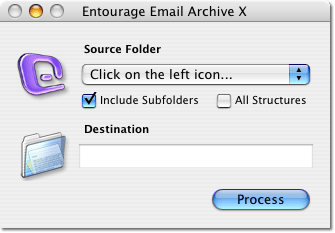
1) Click on the top-left icon  in order to load the folders and subfolders tree of your Microsoft Entourage X emails archive into the popup menu.
in order to load the folders and subfolders tree of your Microsoft Entourage X emails archive into the popup menu.
2) Choose, from this pop-up menu, the source Entourage folder you want to archive.
3) Click on the icon  in order to define the main destination folder (on the disk) to archive your emails to.
in order to define the main destination folder (on the disk) to archive your emails to.
4) Click on the button Process to start the archiving process. Wait until the progress bar will tell you that the task has been done.
Entourage Email Archive X can archive your emails in five different ways, with further sub-options:
A - Archive emails and/or attachments in the Finder. It produces a Finder-structured-folders archive where emails and/or attachments are grouped by day. It is also possible to enable the feature for saving emails as native Entourage X file format.
B - Backup to the Finder. It produces a Finder-structured-folders archive where emails in native Entourage X file format are grouped by year and month. It is possible to browse the archives generated with first 4 settings and quickly locate informations inside thousands and thousands of emails using utilities like Find by content of Apple or iPassepartout.
C - Export or append email to a text file that can be read by a text editor or a word-processing program. It produces a long paper trail file that can be viewed with a robust text editor like BBEdit, Text-Edit Plus or Microsoft Word.
D - Export or append email to tab-separated text file that can be imported, for example, into FileMaker Pro.
For this export function a free template is enclosed in the Email DB for FM Pro folder in the Entourage Email Archive X folder.
It produces a tab-text file that can be imported into computer database programs like Filemaker Pro.
With this option you can save attachments files, or in addition, you can save the emails as original Entourage format.
The FileMaker Pro template we provide together with EEAX will let you handle the emails and reveal the attachments with a simple click.
E - Archive emails by address. This choice produce a Finder-structured-folders archive where emails and attachments are grouped by day and time folder.
With the following five kinds of archive (A1, A2, A3, B1, D1, E1) EEAX can recognize if an email has already been exported.
In this case there will be a line in the Log stating: Skipped emails (already archived)
When using other kinds of archive, EEAX always exports all emails found.
In order to obviate the need to delete emails from Entourage by hand once they have been archived, EEAX may be configured to delete them automatically at the end of the archiving process.
After you launch EEAX the main window appears.
At the top you will find the Entourage X icon. Click on it to load the structure of folders and subfolders of Entourage X into the popup menu Source Folder.
The user can include all subfolders by clicking the checkbox Include Subfolders.
The checkbox All Structure is for archiving the complete Entourage X structure.

In the Destination box, the user can select the main folder or file (depending on which Preferences have been chosen).
About Include Subfolders and All Structures
Include Subfolders: if the source folder contains some subfolders and you checked the check-box Include Subfolders, EEAX will process (and save) the subfolders and their content too. If otherwise you didn't check the check-box Include Subfolders, EEAX will never process (and save) the subfolders and their content.
All Structures: If you checked the check-box All Structures, EEAX will process (and save) all the Entourage X folders structure, regardless the source folder you defined.
Note: EEAX replaces automatically, if present in one or more Entourage X folder structures, the colon character (not permitted for naming folders in the Finder) with the - character.

Before using Entourage Email Archive X, choose Preferences from File Menu.
There are four tabs: General, Text, Tab-Text and Filters.
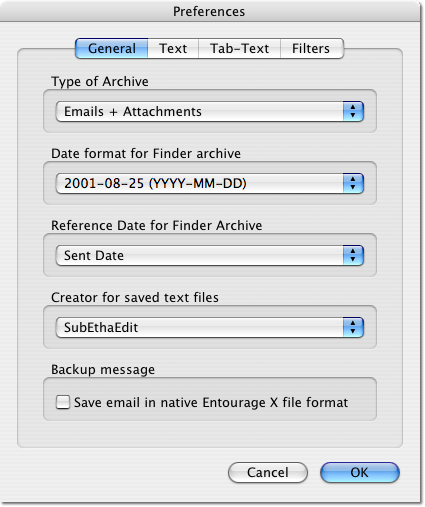
Type of Archive
The first three choices (Emails + attachments - Only emails - Only Attachments) produce a Finder Archive, that is a structure of folders and subfolders where the emails are stored by day of the year and time of the day. For browsing this kind of archive we recommend to use the Apple Find command or similar utilities (iPassepartout is the best tool for this purpose) that can search also in the contents (read Browsing Archives section below for more information.)
In this example the structure of folders and subfolders of Microsoft Entourage X is shown.
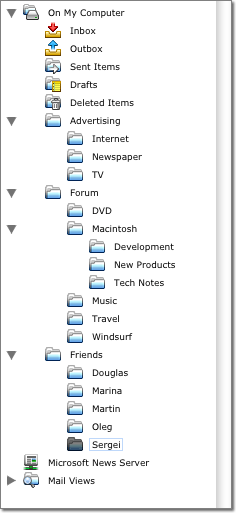
When you firstly use Entourage Email Archive X we suggest you to create the same structure of folders and subfolders in the Finder as you have in Microsoft Entourage (although this structure can be created automatically if you set All Structures).
Later simply choose the destination folder in EEAX’s main palette.
(See About Include Subfolders and All Structures for more info)
The resulting Finder archive will be like the one in the following example:

All the emails are organized in two folder-levels, the first one containing the second one.
The first and top level is the day folder. Within each day folder, you'll find the second level, that is the email folder.
The day folder is labeled with the year-month-day string. Inside each day folder, you will find all the emails received on that day.
Each email received is represented by a folder labeled with the Entourage ID Message Number and the Time the email was received or sent (e.g. (1406) Time 00.58.12).
Within this folder EEAX will save the emailText/attachments/native Entourage X file according to the settings chosen.
The other two choices from the popup menu are for archiving only emails or only attachments.
The emails will be saved with the creator (BBEdit, etc) that has been specified in the Preferences.
Attachments are saved in the original format (StuffIt, Compact Pro, native files).
This kind of archive is not intended to be browsable manually in the Finder, even if information can be located exactly.
To search inside your email archive you can use the Find feature, which permits searches of the contents of the files if they have previously been indexed (refer to the Browsing Archives section for more information) or use tool like iPassepartout that doesn't require indexed data.
Backup Emails as .eml files
With this feature (setting B1), EEAX saves the emails to a Finder Archive with the Native Entourage X file format (.eml files).
Emails are grouped in a folder named with Year and Month of reference date.
File name is named as Email ID and Subject.
This setting is useful because using Apple Find or utilities like iPassepartout or similar, it is possible to search directly inside the contents of these files. In addition is very simple to restore any situation because inside each primary folder (Inbox, Sent Items, Friends...) there are maximum 12 folders for year.
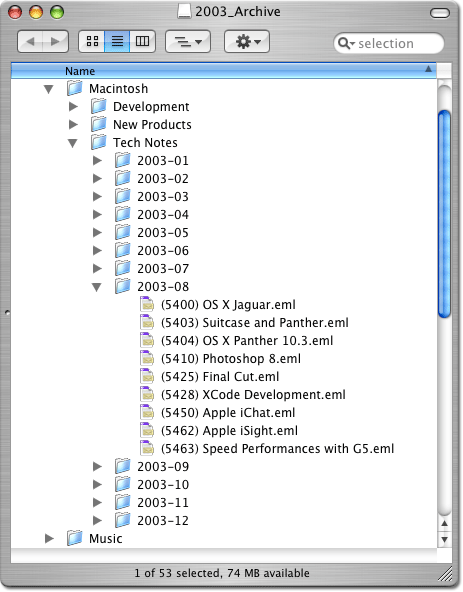
Export new text file - Append to text file
When the command Export new text file (setting C1) is selected, a blank destination file is created (click on the icon folder on main EEAX window) and then filled with the entire contents of the email messages:
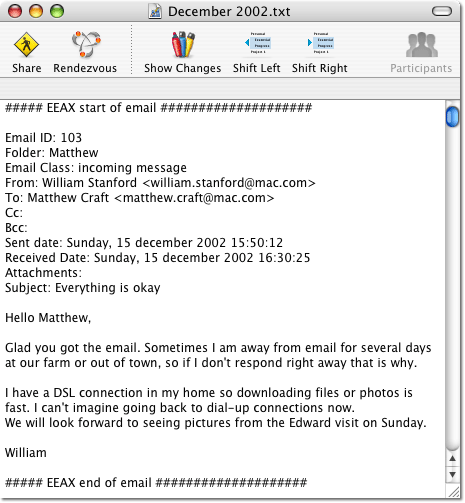
A line delimiter (start/end) is used between each email to facilitate reading and possible post processing for parsing.
When the command Append to text file is chosen (setting C2), EEAX adds the email messages to the end of an existing file, after the previously archived messages.
Export new tab-text file
The command Export tab-text file (setting D1) is for generating a text file suitable for importing data into a database like, for example, FileMaker Pro.
A free template for FileMaker Pro 5 or 6 is included (in the folder Email DB for FM Pro).
Users can change or modify the scripting and layout.
Append to tab-text file
When the command Append to tab-text file is chosen (setting D2), EEAX appends the email messages to the end of the file.
Archive emails by Email Address
With this feature all emails are grouped by email address, and the Entourage X folder structure is not considered.
For received emails (incoming) the email address key is the Sender, for Sent emails the email address key is the Destinatary (To recipient).
To better organize all emails, EEAX generates two folders (Received and Sent) inside each specific email-address folder.
Inside the Received and Sent folders, emails and attachments are saved inside a folder named with the date formatted as YYYY-MM-DD plus the time in HH-MM-SS (espressed as time 24 hours) plus the email ID (each email in the Entourage X Database has a unique ID number).
Again, to find information in the file system structured in this way we suggest using Apple Find or utilities like iPassepartout or similar.
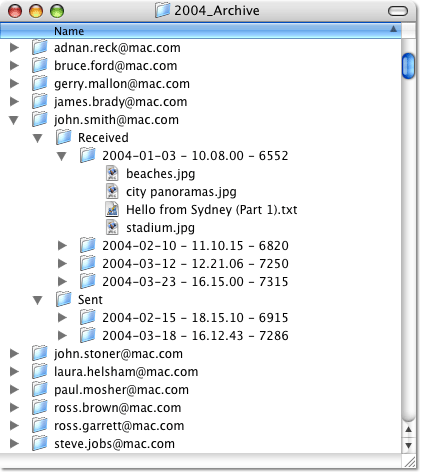
Creator for saved files
All text files saved will be saved with the creator chosen.
The list of creator choices is as follows:
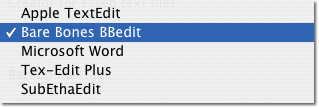
Date format for Finder Archive

You can set the date format which is used in the names of the folders created with the following types of archives:
Emails + attachments
Only Emails
Only attachments
by choosing one of the following five settings from the popup menu:

In the example, the number (342) before the date 8 December 2001 indicates the progressive number of the day of the year (from 1 to 365 or 366).
Reference Date for Finder Archive
This setting is applied only when the user chooses to archive emails as:
Emails + Attachments
Only Emails
Only Attachments
Backup emails as .eml files
In all of these cases EEAX generates a Finder Archive as explained above.
To generate the first level (day folder), EEAX gets the date of the email.
To generate second level (time folder) EEAX gets the time of the email.
Because emails have both the Sent Date-Time and Received Date-Time, user can decide which date EEAX uses to generate first level and second level folders by the following two choices:

If you choose Sent Date, EEAX will always name the email folder with the Sent Date, both for the emails sent and the emails received.
If you use Automatic, EEAX will name the email folder with the Sent Date in case of emails sent (outgoing message), and will name the email folder with the received date in case of emails received (incoming message).
Until version 1.6.1 EEAX has used only Automatic. Why did we add a second choice?
Simply because using some versions of Entourage X during import of emails from older versions of Outlook or Entourage or other programs like Netscape or Eudora, Entourage X stamps all imported emails with the received date at the moment of the operation. That meant that if user started to use Entourage X and imported all his previous emails from Outlook, all emails will have the same received date and consequently will be archived under the same day by EEAX. With the new option to use Sent Date this problem is solved.
Backup message
When this checkbox is enabled and the user chooses one of the first three kinds of archives A1, A2, A3, (that is, email+attachment, only emails, only attachments) EEAX writes, in the Finder Structured Folders archive, the emails as native Entourage X file format, in addition to the message saved as TEXT and the related attachment, according to the preferences chosen.
The email written as native Entourage X file format is always named as (Email ID) myMsgBackup.eml.

The file .eml preserves the HTML attributes and also the attachments in native Entourage X file format.
User can search in the archives with Find command, as explained in the related section and now it is possible at any time to restore one or more messages by simply following the procedure explained below.
Restore Archives
With the option to have messages written in Entourage X native file format it is possible to:
- Restore at any time single or multiple messages (a particular email or for example all emails of Sent Items folder maybe sent in the last 6 months)
- Import emails in other Microsoft products like Outlook Express or Entourage for Office 2001.
- Move emails back and forth between Microsoft products.
- Import emails in Microsoft Windows versions like Outlook Express.
This feature is also available in OEA and EEA and lets you move emails between Microsoft products.
Usually with the standard function in email browsers is possible to import archives from Outlook Express to Entourage or Entourage X, but not in the opposite direction, from Entourage X to Outlook Express for example.
How to restore messages:
Just locate the file with the Find command in the Finder structured folder archive related to the wanted email and drag and drop it onto the Entourage main window.

If you want to restore a lot of emails (for example all the emails of the Sent items folder or emails of the folder Tech Notes), just locate it with Find command and after selecting all the messages, drag and drop them to the Entourage X main window. That's all. After the mouse is released Entourage X will import all the selected emails and they will appear with the original Subject. This permits restoring at any time partial or full groups of emails.

Internet Header
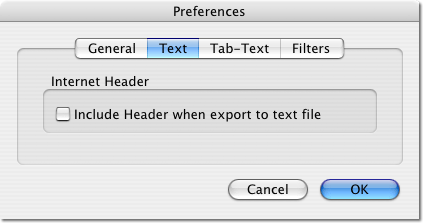
Enabling this check box will write the Internet Header of emails when EEAX exports emails as text files.
Date format for tab-text file

In the popup menu Date format for tab-text file choose the correct setting for your FileMaker Pro archive.
Two settings are available:

Month-Day-Year (USA format)
Day-Month-Year (European - Rest of the World format)
Example:
Choosing the first setting (USA) results in the email date 14 May 2002, being written to tab-text file as:
5-14-2002.
Choosing the second setting (Euro) results in the date being written as 14-5-2002.
This is very important for correctly importing data into FileMaker Pro archives.
Starting from EEAX 2.x you can export your emails to a tab text file containing references to your attachments.
The FileMaker Pro template we provide together with EEAX will let you handle the emails and reveal the attachments with a simple click from within a database file.
In the Preferences area you will find a new area entitled Attachments - Backup email.
When you enable the checkbox Attachments or .eml file, EEAX save in the destination folder the following structure:

Each email is analized and based on class of email (incoming or outgoing), the date of email is taken for generate a structure based on Year/Month/.
Inside this structure, a folder with the unique ID of email is generated and will contains all attachments of the email.
In the new FileMaker Pro Template it's possible to define the root-folder of the tree where EEAX saves the emails.
This way you can easily move your root-folder to another location or disk then all you have to do is to tell your FileMaker template the new location of the root-folder.
In the FileMaker template click on Configure button and press the button Select Archive root-folder.
In the example below the folder Archive inside the disk Development has been defined as root-folder for the structure generated by EEAX.

For reveal attachments in the Finder, simply click the small folder icon in the Email DB 3.0 template:

Filters
There are three choices:
In the cases 2 and 3 the user has to specify the number of days using the stepper.
The user can therefore choose to archive/export only emails older than, for example, 30 days, or archive/export only emails that have been sent/received in the last, say, 50 days.
Shortcut: with option key pressed you can increase/decrease 10 days at time, with command key pressed 50 days at time.
To disable this feature and archive all emails simply choose Disabled from popup menu.

The free FileMaker Pro template entitled Email DB 3.0 inside the folder Email DB for FM Pro 6 & 7 can be used for archiving all the emails exported with the function Export tab-text file. The template was produced with FileMaker Pro version 6 and is available also for version 7.
Before importing data into FileMaker it is important to select from the popup menu of FileMaker Pro the option Tab-Separated Text Files as in the following example:
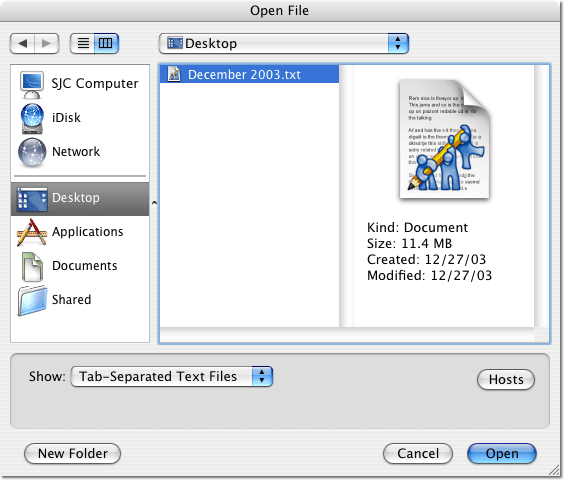
The following fields are exported:
Email ID: internal reference email ID of Microsoft DB
Microsoft Folder: name of the folder or sub-folder where email is located.
Email Class: class of message (incoming message or outgoing message)
Categories: the categories assigned to email in Entourage.
From: the sender of email (display name and email).
To: list of addresses (display name and email separated by commas).
Cc: list of addresses (display name and email separated by commas).
Bcc: list of addresses (display name and email separated by commas).
Sent Date: the date the email was sent.
Sent Date Seconds: the time the email was sent.
Received Date: the date the email was received.
Received Time Seconds: the time the email was received.
Attachments: the list of attachments name (separated by commas).
AttachmentPath: the relative path of structure in the file system.
Subject: the subject of email.
Headers: the headers of email.
Body: the content of email.
When a new tab-text file is created, the first record is the list of the field labels (although importing into FM Pro is very simple this facility should assist in matching the fields between the file and the FM Pro Archive).

If you want to import your old Email DB 2.0 data into the new Email DB 3.0 FileMaker template, please click on the button Import from Email DB 2.0 button in configure area.
Then select your previous Email DB 2.0 file and wait until the import procedure will be completed.
Important Note:
To import data from the FileMaker Pro archives prior versions, simply match the fields by field name.
The fields named starting with DEV_ are for internal use only. You don't have to import these fields.
The length of FileMaker Pro text fields is limited to 64 KB.
Structure Report
This command show complete Entourage X structure and report for each folder the total number of messages.
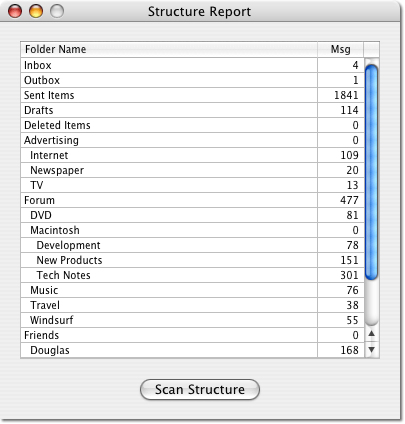
Delete Archived Emails
Choosing Delete Archived Emails from the File menu (only for registered copies) will open a window where it is possible to start the process that moves all previously archived emails to the Entourage X folder Deleted Items.
The messages are retrieved from the last session of archiving.
Once an archiving session has been completed, if you want to be able to use this feature, we strongly recommend you not to quit EEAX.
When emails have been moved to the Entourage X folder Deleted Items the user can choose to delete them manually or to activate from Entourage X the schedule command Empty Deleted Items Folder on quit.
In the latter case it should be noted that Entourage X can take a long time to delete emails from the internal Microsoft database (this depends on the number of emails in the Deleted items folder).
Log
Every time Entourage Email Archive X processes a folder, it writes a Log file. The Log file is a text file showing the user the history of tasks executed by EEAX. It is possible to see the log by choosing Show Log from the File menu of Entourage Email Archive X.
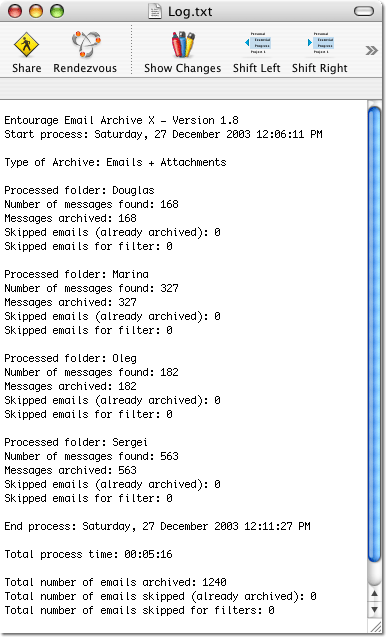
Show Log Errors
If a problem occurs, EEAX informs the user about the error occurred at the end of the session, and writes further info about the error to a special log file.

Using Spotlight in Tiger
Using new Tiger 10.4.x all data archived with settings A1, A2, A3, C1, C2, E1 are automatically indexed, so using new Spotlight technology the data are retrieved in real time.
Using Find to browse Finder structured folders archives (for Panther)
The internal Apple Search Engine called Find (or Sherlock for OS X prior to 10.2 Jaguar) can perform searches inside the contents of files. This means that it is possible (after indexing) to search for any word, or words, in archives with Finder-structured folders created with Entourage Email Archive X.
We suggest storing your archive as a disk image created with Apple Disk Copy or on removable media like Jaz or Zip or on a dedicated partition on your Hard Disk, any of which can be indexed separately using Find (or Sherlock).
Because EEAX can save files with names longer than 31 characters be sure to format your volume/disks as HFS+ or Mac OS Extended (same thing) otherwise you can receive errors during archive processing.
Searching through archived emails is very fast on the indexed disks. OS X stores the invisibles index files inside the disk itself, so when you copy the disk image file (or take your Jaz, Zip, PocketDrive), you will copy the index automatically and you will not have to index your data again.
In this way, your archive is independent and you can copy it to another Mac and perform any kind of search.
Of course, you have to update your Index every time you perform a new Archiving from EEAX but this is a very fast procedure.
After you have exported data from your Entourage X with EEAX using one of the first three kinds of archives you have created a Finder-structured-folders archive. We think this kind of archive is best for History archives. By History we means that you don’t need to have thousands of Entourage emails online, because when you want to search for one specific email you can do this using the quickest possible way: the new Find command of OS X.
Index your archive by following the instructions in Apple Help (select the folder or volume, use the Get Info command, and then turn the Content index triangle).

After having done this, you can ask to find every email that contains specific words.
In the example we created a query to search for every email that contains the words tiff nikon exif
Because OS X performs the search using the boolean operator OR between search words, the results are shown by relevance: long bars mean that Find command has found all the words requested. Short bars mean that emails do not contain all the requested words.
You can construct many types of queries like:
Search for all email sent by John Smith regarding DVD and Piooner or
Search for all email sent by John Smith in December.
You can also perform the search only on some folders of your archive:
simply choose them from Specific places into the Find window and perform the search on every folder or volume (disk) you want.
Find Examples
Query with tiff and nikon and exif on entire disk 2003_Archive
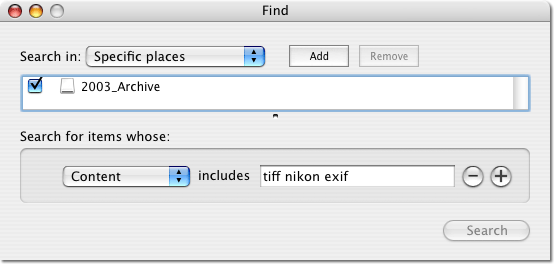
Result of query (long bars mean that search engine has found all the words requested).

Another best tool for search inside the contents of text files is iPassepartout.
Tips for Microsoft Entourage
Microsoft Entourage creates a folder for each user profile.
All of these folders are placed inside the User:Documents:Microsoft User Data:Office X Identities:Identity folder: folder.
Inside each folder is the same structure: all emails are stored in a single file named Database
Creating new messages in Microsoft Entourage increases the size of this file.
When messages are deleted, Microsoft Entourage X DOES NOT reduce the size of this file.
To reclaim this free and wasted space, you have to compact the file using the following procedure:
Launch Microsoft Entourage holding down the option key just before the splash screen appears and until you see the following dialog.
Click on the button Typical Rebuild.

After some minutes, at the end of this task, you will see a dialog which notifies you that all the files have been compacted successfully.
Now you can check in the Finder to see how much smaller the Database file is.
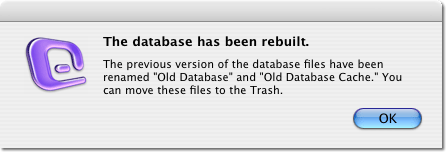
Be sure that you have enough space on your Hard Disk, because Microsoft Entourage X duplicates and saves the old and uncompacted file naming it Old Database and Old Database Cache respectively.
So, at the end of this task you should trash these old files.
Tips for Entourage Email Archive X
You can store the EEAX Finder Archive in a Disk Image created previously with Apple Disk Utility or a similar utility.
Launch the Apple Disk Utility program and select from the Image menu the command New Blank Image.
A dialog will appear. Choose a name and size for your new Disk.


Concerning the size you should assign to your disk: you should know that the data extracted from Microsoft Entourage by EEAX are non-encoded, therefore the EEAX data will use less space on the disk than Microsoft Entourage X did.
Click on the Create button. The disk will be created and shown on your desktop.
Switch to the EEAX application and choose the new disk as the destination disk/folder.
EEAX use the ID number of each email in certain settings during archive/export email.
You need to know that each email in the Microsoft Database has a unique ID number, so if you have more than one identity (from Entourage menu - Switch Identity), please generate two different archives (one for identity A and one for identity B) because in these two identities you can have email with same ID.
Q: Will the registration of EEAX 2.x be valid for updates of EEAX?
A: Yes, the registration will be valid for all the next 2.x free updates of EEAX.
Q: Where should I fill in the registration code?
A: You don’t have to fill in any registration field. Simply place the file Registration Code in the EEAX folder. That’s all. Then launch your EEAX application. Please bear in mind that you MUST NOT modify the content of this file, nor its file name, under any circumstances. The contents of file Registration Code are encrypted.
User action is not required. EEAX reads and validates the code each time it is launched.
Q: I'm a registered user of OEA/EEA. When I move my Registration Code inside EEAX folder I receive an error message.
A: EEAX is a native Mac OS X application that has been completely rewritten to run in native mode under OS X. EEAX requires a different Registration Code.
Upgrades from OEA or EEA are available at http://order.kagi.com/?7BY
Q: I'm registered User of EEAX 1.x? My registration Code don't work with new EEAX 2.x
A: EEAX 2.x is a new version requiring an upgrade fee. You can upgrade your copy of EEAX 1.x for $12 at KAGI store: http://order.kagi.com/?7BY
Q: When I launch or set prefs of EEAX I receive this error Network file permission error. (-5000)
A: If user privileges of files inside the EEAX Prefs folder (located in User/Preferences/EEAX Prefs/) are not correct this problem will appear. Try to run Apple Disk Utility and Repair Disk Permissions (under the First Aid tab). If the problem persists, manually change the permission of EEAX Prefs and its files (File > Get Info > Ownership & Permissions) or contact us.
Q: If I include Save emails in native Entourage file format, does the size of my archive change?
A: Yes, saving archives as Emails + Attachments or Only Attachment AND native Entourage file format .eml, doubles the space of archive because attachments are also embedded in native Entourage file.
Q: When I export as tab-text file and after importing the file inside the FM Pro template, the fields don't match.
A: Before importing data into FileMaker it is important to select from the popup menu of FileMaker Pro the option: Tab-Separated Text (see section Archive emails using FM Pro template in the manual).
Q: What limitations are part of the unregistered version?
A: The unregistered version can process only 20 emails at time. After that number, the user must quit and relaunch EEAX to use it again. The second limitation is that the feature Delete Processed Emails is disabled.
Q: Is EEAX compatible with the new Office 2004?
A: EEAX 1.9.2 and EEAX 2.x has been tested successfully with latest Entourage included in Office 2004.
Mac OS X Panther 10.3.x or Tiger 10.4.x
Microsoft Entourage X (included in Office X) or Entourage X 2004 (included in Office 2004)
2.3
EEAX 2.3 has been tested and is full compatible with the latest Office 11.2.1 patch and with Mac OS X 10.4.3
The location for exporting attachments as tab-text area is now preserved.
Tutorial movies for the use of EEAX and the enclosed FileMaker Pro template are available on our web site.
Filemaker Email DB template is now version 3.1 and can be used with FM Pro version 5, 6, 7 and 8:
- Added attachment field to all the 3 lists view layouts.
- Added two new layouts listing all the emails sent from a specific email address or to a specific email address. This without perform a search. This new feature can be activated simply clicking on the small lens in the form view.
- Other minor changes to the interface.
2.2
EEAX is now compatible with Tiger and take advantage of search possibilities from the new Spotlight technology.
Fixed tab text file export under Tiger.
Minors internal changes and adaptions for Tiger.
Tested successfully with latest Panther 10.3.9 and Tiger 10.4.1
Updated manual and FAQ section.
2.1
Fixed: export new text file no longer generate errors (bug is present in EEAX 2.0 only).
Speed improvements to Save attachments routine for FileMaker Pro.
FileMaker Email DB template no longer require password. Now they are unlocked, so user can modify layouts/scripts for personal customizations. Email DB 3.0 is free.
French version of manual has been aligned to English version.
Fixed startup delay for unregistered version.
2.0
EEAX now manage attachments files using the new FileMaker Pro template entitled Email DB 3.0.
The new template has been completely rewritten from scratch: new elegant interface, new functions, new sorting fields, new list views, new configure panel...
Email DB is free and Registered Users of EEAX 2.0 will receive the password for unlock it for personal customization.
Email DB template is available inside EEAX 2.0 bundle for both FileMaker Pro 6 and 7.
Fixed refresh of keyboard shortcuts in filters area.
Internal changes to interface and minors internal routine optimizations.
Tested with OS X 10.3.8 and latest Office 2004 patch.
1.9.2
Fixed the date format label in the preferences area.
Tested with the latest Office X 10.1.6 and Office 2004 11.1.0 updates.
Optimized some internal routine for speed.
1.9.1
Successfully tested with new Entourage X 2004
Recompiled with latest Apple Xcode 1.5
Tested with Mac OS X 10.3.5
Minor improvements.
1.9
Added the feature to archive emails by email address. All emails are grouped by specific email address (for sender and recipient). Inside each folder named with a specific email address are two folders: Received and Sent. Within these folders, emails and attachments are further grouped in folders named with the date and time and ID number of the emails.
The routine "Delete Processed Emails" has been rewritten. Now it is faster and can capture potential errors.
Fixed a bug when email subject was longer than 254 characters.
Fixed a bug that prevented choosing a disk or disk image as the destination for an archive.
Recompiled version with the latest Apple XCode 1.2
Minor changes to interface of Filter area.
Tested on latest version of OS X (10.3.4) with Office X.
1.8.1
Fixed a bug, introduced by the last version, which disabled Reference Date Popup in case type of archive was set to New Text file or Tab Text file.
Improved controls for check validity to Output destination folder/file according to the preferences chosen.
As requested, we added new settings for archiving emails as native .eml files. Emails archived this way are grouped in a level folders named by year and month (YYYY-MM). In order to quickly get informations about these archives, please use tools like Apple Find or iPassepartout.
The interface of Preferences has been rearranged. The tab-view "Structure" has been merged with the tab-view "General". In case of emails with more than one attachmnent with a same filename, EEAX will append a prefix at the begining of each attachment.
Added a new feature for saving text files with the Creator of the text editor "SubEthaEdit".
Tested compatibility with the latest MacOS X 10.3.2 and Office X 10.1.5
Minors changes to interfaces. The splash screen includes now a direct link to register the application.
Minor fixing at the progress bar and status message field.
The HTML manual has been updated with new screenshot.
Various minor improvements.
1.7
As requested, EEAX can now save emails in the Finder Structured Folders Archive by getting the original email Sent Date as a reference. A popup menu in the preferences allows user to choose Sent Date or Automatic (Sent Date for outgoing email and Received Date for incoming email). Please read the manual about the differences between the two methods and why we introduced them.
New Structure Report window shows complete tree of the Entourage X folder structure, including total number of emails in each folder.
As requested, a new tab view Text in Preferences was added with check box for exporting the Internet Header of emails when EEAX exports emails as text files.
Positions of main window of EEAX, Structure Report window, and Preferences are now remembered at the next relaunch.
Added various tool tips in the preferences.
Minor internal improvements and optimization.
Minor changes to interface of structure Report window.
English and French versions of manuals updates.
1.6.1
Fixed bug related to reading Registration Code at startup.
EEAX manuals are now available in English and French versions.
EEAX 1.6 now preserves Unicode characters for non-Roman languages (like Japanese, Chinese, Thai, Cyrillic...) when saving emails and attachments to Finder-structured folder archive using the first three kinds of archives (Emails + attachments, only emails, only attachments). Filenames of files are now displayed in the Finder as in Entourage X.
The process window has been completely redesigned. Process window now shows the total number of emails to process, estimated remaining time and the current examined folder.
The Filter section in Preferences has been refined. There are now 3 choices: Disabled, Archive emails older than, Archive emails newer than, with the ability to see the date that EEAX uses for reference. A small stepper (the range is from 1 to 1000 days) is used to input the number of days. Shortcut for stepper: option key increases/decreases by 10 days, command key increases/decreases by 50 days.
Speed has been increased. EEAX is now about 10 percent faster.
The final Log report shows more info about each processed folder and the summary of total archived/exported emails.
Fixed bug during startup that occurred if the full pathname to EEAX contains non-Roman Unicode characters (Japanese, Chinese, Thai, Cyrillic...).
Recompiled and optimized to run in Jaguar OS X 10.2. EEAX 1.6 runs now only on OS X 10.2 or higher.
Unregistered version can now manage 20 emails per session.
FAQ section of the manual has been expanded.
Tested compatibility with latest version of OS X 10.2.5 and 10.2.6
1.5
Recompiled and optimized to run in Jaguar OS X 10.2. EEAX 1.5 runs now only on OS X 10.2 or higher.
Fixed a minor bug when saving attachments whose file name contains a colon : character.
Some routines have been completely rewritten and improved.
Log now reports that email was saved in native Entourage X file format if selected in Preferences.
EEAX no longer shows the startup splash screen if the application is registered.
Some minor changes have been made to the appearance of icons in the main window.
Added the menu command Show Errors Log in the File menu.
The Log Errors file now reports more detailed information.
Added feature for save messages in native Entourage X file format.
The messages are now saved and named as: (Email ID) myMsgBackup.eml
It is now possible to:
- Restore at any time single or multiple messages (a particular email or for example all emails of the Sent Items folder sent in the last 6 months)
- Import emails in other Microsoft products like Outlook or Entourage.
- Move emails back and forth between Microsoft products.
- Import emails in Microsoft Windows versions like Outlook Express.
Manual revised and updated.
1.3
Fixed a bug occurring when one of the Entourage X folders contains a colon : character and the kind of archive of EEAX was set to Finder structured folder archive. Now EEAX replaces automatically the colon character, which is not permitted in the Finder, with the - character.
Fixed a bug occurring whenever the Cc or Bcc contained only a blank-space character.
Tested compatibility with latest version of OS X 10.1.5 and Entourage X 10.1.0
When EEAX exports as new text file, added line delimiter to start/end of email to facilitate post parsing.
Added EEAX version in the log.
In the section Filter located in the Preferences area it is now possible to choose from the popup:
Archive emails older than
Archive emails newer than
In both selections the user must specify the number of days in the appropriate text box.
This way the user can choose to archive/export only emails older than, for example, 30 days or archive/export only emails that have been sent/received in the last, say, 5 days.
The headers of the messages are now exported as a new field in the tab-text file format.
The free FileMaker Pro template has been modified to accommodate this new field.
The interface has been completely changed and more functionality has been added.
A new script in the FileMaker Pro template allows the user to find and delete all duplicated emails.
Internal optimizations.
Minor changes to interface.
1.0
This is the first official EEAX version after some beta releases.
Added a feature for handling Tex-Edit Plus creator files (see the preferences panel).
Fixed a bug for checking the validity of the destination folder.
The commands Hide EEAX, Hide Others and Show All (on the File menu) now work properly.
Made various optimizations to some internal routines.
EEAX is now compatible with OS X 10.1.4
The filter feature located in the preferences area has been fixed.
Various internal improvements.
Added command Delete processed Emails: it is now possible to delete email messages that are retrieved from the last session of archiving.
The command Show Log no longer generates an error if the file does not exist.
Improved check for Registration Code during startup.
Improved check for System requirements during startup.
Minor changes to process window: process can now be stopped by pressing escape.
Manual has been extended.
Minor internal optimizations.
Paying for Entourage Email Archive X is fairly simple. There are two methods.
On the Web (quick, easy and secure payment on-line) and by the Register application (off-line).
To register on the web:
Go to the web page http://order.kagi.com/?7BY
1 - Choose the product and how many copies you want.
2 - Click on the button Continue and the invoice form will appear.
3 - Fill in the fields with your name, email, address, credit card data and then click on the button Purchase. That's all.
Don't forget to include your email address. If you haven't got one, send a friend's email address.
We cannot accept orders without an email address because we can only send the Registration Code file (which unlocks the shareware limitations) by email.
Kagi will send you the approved invoice in 3 days at maximum (usually in few a hours or minutes).
After that you will receive from us via email a small text file called Registration Code to put inside the Entourage Email Archive X application folder.
This text file will unlock the shareware limitations.
We usually send the Registration Code within 24 hours (sometimes even in a few hours), so if you haven't heard anything after 3 days, most likely you have given us an invalid email address.
In that case, please contact us at info@softhing.com providing an alternative email address.
To register off-line by the Register application:
You need the Register application that accompanies the Entourage Email Archive X package.
If the package doesn't include the Register application, you can download it from http://www.softhing.com/download/register.sit
1 - Launch the Register application (that run under Classic OS9), enter your name, email address and the number of single user licenses or other licenses you desire.
2 - Save or copy or print the data from the Register program and send the data and payment to Kagi (the best way is via email to sales@kagi.com).
Kagi is the company which handles our payment processing.
The fastest way (maximum 3 days, but usually a few hours) is to save the invoice to a text file, choosing via email, and send that text file via email, as an attachment, to sales@kagi.com. You can also open the invoice text file with an editor (e.g. Apple TextEdit) select all the text, copy and paste the text to the email message body just as it is (without making any changes).
Don't forget to include your email address.
If you haven't got one, send a friend's email address.
We cannot accept orders without an email address because we can only send the Registration Code file by email.
Kagi will send you the approved invoice in 3 days at maximum (usually in few a hours or minutes).
After that you will receive from us via email a small text file called Registration Code to put inside the Entourage Email Archive X application folder.
This text file will unlock the shareware limitations.
We usually send the Registration Code within 24 hours (sometimes even in a few hours), so if you haven't heard anything after 3 days, most likely you have given us an invalid email address.
In that case, please contact us at info@softhing.com providing an alternative email address.
If you are paying with Cash or USD Cheque you should print the data using the Register application and send it to the address shown on the form, which is:
Kagi
1442-A Walnut Street #392-7BY
Berkeley, California 94709-1405
USA
You can pay with a wide variety of cash from different countries but at present if you pay via cheque, it must be a cheque drawn in US Dollars. Kagi cannot accept cheques in other currencies.
If you have a purchasing department, you can enter all the data into the Register program and then select Invoice as your payment method. Print three copies of the form and send it to your accounts department. You might want to highlight the line that mentions that they must include a copy of the form with their payment.
Kagi cannot invoice your company, you need to act on my behalf and generate the invoice and handle all the paperwork at your end.
Please do not fax or email payment forms that indicate Cash, Check or Invoice as the payment method. As far as we know, there is still no technology to transfer physical objects via fax or email and without the payment, the form cannot be processed.
Payments sent via postal mail take time to reach Kagi and then up to 10 days for processing.
Again, if you include a correct email address, you will hear from Kagi when the form is processed.
For any information about the software, or to notify us of bugs or to request enhancements:
Email: info@softhing.com
Web Site: http://www.softhing.com
For further information about the payment:
Kagi - Email: sales@kagi.com
Web Site: http://www.kagi.com
Special thanks for EEAX development to:
Douglas, Sergei, Oleg, Hervé, Martin, Alexander, Frank, Nonik Skat